Blog Archives
September 15, 2003 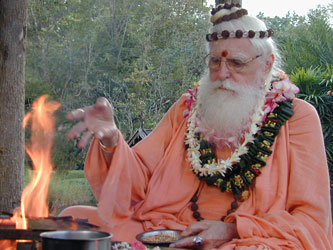
"God Siva created us. He created the earth and all things upon it, animate and inanimate. He created time and gravity, the vast spaces and the uncounted stars. He created night and day, joy and sorrow, love and hate, birth and death. He created the gross and the subtle, this world and the other worlds. There are three worlds of existence: the physical, subtle and causal, termed Bhuloka, Antarloka and Sivaloka. The Creator of all, Siva Himself is uncreated. As supreme Mahadeva, Siva wills into manifestation all souls and all form, issuing them from Himself like light from a fire or waves from an ocean. Rishis describe this perpetual process as the unfoldment of thirty-six tattvas, stages of manifestation, from the Siva tattva--Parashakti and nada--to the five elements. Creation is not the making of a separate thing, but an emanation of Himself. Lord Siva creates, constantly sustains the form of His creations and absorbs them back into Himself. The Vedas elucidate, "As a spider spins and withdraws its web, as herbs grow on the earth, as hair grows on the head and body of a person, so also from the Imperishable arises this universe." Aum Namah Sivaya.
Our Beloved and Revered Satguru Sivaya Subramuniyaswami
Attained Maha Samadhi on November 12th, 2001
Click to read for Details.
We are pleased to announce the web release of Satguru Sivaya Subramuniyaswami's monumental work on Hindu culture and lifestyle:
Living with Siva.
Click here for the entire text and artwork, now on-line!
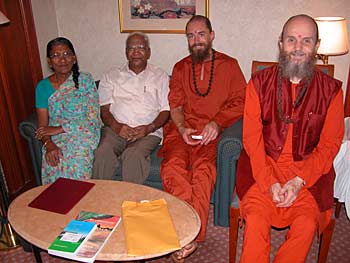
Bodhinatha meets in Singapore with Hindu elders, Mr. and Mrs. Rajathurai. Mr. Rajathurai, now retired from service in the fields of education and telecommunications, was Secretary of the Hindu Advisory Board (to the Singapore Government) for two terms and a leader in the Sengapa Vinayagar temple activities for over 25 years. He has been a enthusiastic supporter of Gurudeva's work through the years, actively facilitating our members projects and activities whenever possible.
Bodhinatha's Sun One Video. Most Recent update: September 12, 2003. Bodhinatha speaks on Ahimsa, noninjury, yama #1, which is noninjury in thought, word and deed. The law of karma decrees that it is wise not to harm or hurt others, for we will then receive harm and hurt in exchange in the future. 12 minutes, 29 seconds.
 |
|
|
|
Live Web Cam Pix! |
 |
||||
Members of another prominent Singapore temple, the Muniswarar Temple, come to the hotel to talk with Bodhinatha about their wish to have Sanskrit classes for the children.
President of Muniswarar Temple, on right.
That evening an event was held for Bodhinatha at the Hindu Center... devotees gathered in the long narrow hall...
Bodhinatha's talk: "I want to see God: Suggestions for where and how to look."
Sivakumar Saravan is teaching classes on Hinduism to the youth at this Hindu Center.
The Hindu Center asked him to develop a four year course of teaching, which he is doing based on the Master Course trilogy.
After the talk everyone came forward for vibhuti.
Hindu Center leaders.
Projects by the students of Sivakumar's classes
All about Lord Ganesha mantras.
Outside the hotel.
It was a very intense trip... 19 days in all. A brief respite from activities.... going for a walk outside.
Singapore is a remarkably well maintained urban environment. You have to go there to understand what we mean....
Sivakumar Saravan discussing his class materials development with Bodhinatha
Now here we are on September 9th, the last day in Singapore, with Karttikeya Sivacharaya meeting Bodhinatha at the hotel.
Meeting with representative of Senpaga Vinayagar Temple which wishes to begin children's classes based on Gurudeva's teachings. This temple was founded by Sri Lankans and is very close to the Siva Yogaswami Paramapara.
Saiva Siddhanta Church sishya Sambandan Umamahesvaran on the left is helping the Vinayagar Temple liaison with Bodhinatha.
Kulapati Dohadeva Samugam, who along with his wife Nagavathy have been our long time "anchor" team and backbone for the Saiva Siddhanta Church Singapore mission, Nagavathy also takes care of the distribution of Hinduism Today in Singapore.
Thambynathan Girish Samugam who has renewed his Aspirancy and is considering becoming a monk one day.
That evening a big event at the Senpaga Vinayagar... Bharata Natyam first...
A table on the stage with pictures of Yogaswami, Gurudeva and a big introduction sign for Bodhinatha.
Bodhinatha gives a talk on issues of religious conversion, comparing dance to the spiritual path, and ways to see God.
Then some members of the audience ask questions.
More questions.
And more...
The audience comes up for vibhuti prasadam.
Around two dozen copies of Dancing with Siva pocketbook edition were brought up for signing.
Natarajnathaswami gives fruit prasadam while I (Saravananathaswami) take photos.
One of the things that struck Bodhinatha on this trip was "so many children everywhere!"
A new generation that will group up with Gurudeva's teachings
And then, after 24 hours of travel... back home after a very, successful mission.
Our team back at home base.
This ends the official documentary of the 2003 mission to Asia, though we receive more "vignettes" from behind the scenes in the days ahead.
All the monks at Kauai Aadheenam want to send their gratitude and appreciations to all the sishya and devotees who work tirelessly to make this journey a success. Clearly, we have a great future ahead of us!
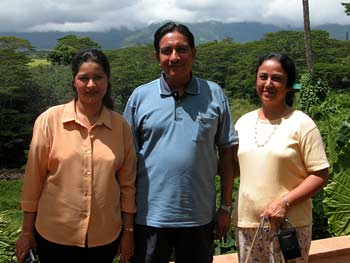
We hosted a wonderful family of three who came straight from Bangalore. In all the Hawaiian chain of islands, little did they know when the chose Kauai, they would be coming a sacred treasure trove. The Segal family enjoyed the tour of the grounds and plans to come to Kauai whenever they visit their sister who lives in the mainland, US.What a surprise to find such a magical Hindu temple in the middle of the Pacific, with a magnificent temple carving project in their home town! Upon returning to Bangalore, they would like to go for a tour of our Iraivan carving site there.
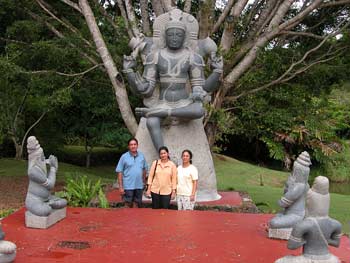
With Dakshinamurthi
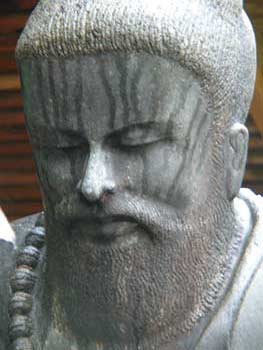
A close up of the statue of Tiruvalluvar, just after a light rain.
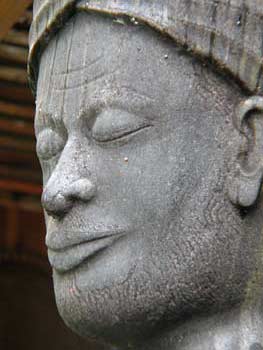
Tirumular....

We are having an excellent few days of rain interspersed with sun... this is a great picture of the mountain range in the morning...
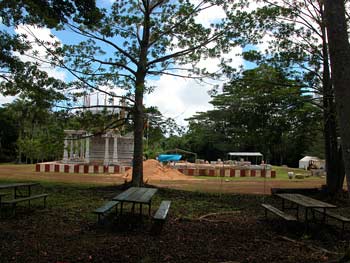
Iraivan from the west side.
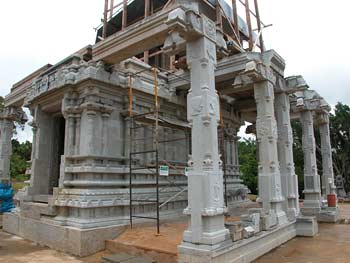
Above, painstaking work is in progress on course 17A... the "foundation" level for the vimanam tower. More about that tomorrow.
No Audio Today
|
Be surprised! Take this opportunity for an adventure. Close your eyes and click to get a message picked at random from the vast audio archives of our Satgurus' discourses |
And click here for an Index to All Past CyberTalks.
|
| FULL INDEX OF 650+ CYBERTALKS
 |
|
Study Gurudeva's teachings.
|
transcription begins
Date: August_14_2003
Title: The Niyama of Vrata, Vows
Category: Yamas and Niyamas
Duration: 11 min., 19 seconds
Date Given: July 22, 2003
Given by: Bodhinatha
Good morning, everyone! Welcome to our guests, pleasure to have you with us.
This morning we are continuing our series on 'Yamas and Niyamas', Hinduism's Code of Conduct, twenty basic principles. We are developing this material for use in the field, for teachers to use. It is in the form of a lesson that takes about 10 minutes to read, kind-of develop what Gurudeva has presented in 'Living with Siva'. He has given us wonderful material on each of these yamas and niyamas. so, we are just trying to develop that and give examples and illustrations and bring in some points from his other books that aren't included.
Today, we are upto the eighth Niyama of Vrata, which is to embrace religious vows, rules and observances and never waver in fulfilling them. Honor vows as spiritual contracts with your soul, your community, with God, Gods and guru. Take vows to harness the instinctive nature. Fast periodically. Pilgrimage yearly. Uphold your vows strictly, be they marriage, monasticism, non-addiction, tithing, loyalty to a lineage, vegetarianism or non-smoking.
All of the Niyamas focus on expressing the refined soul qualities within each of us. In the case of Vrata, the divine quality we are expressing is becoming a more spiritual person through vowing to the inner worlds, as well as to family and community, to observe certain practices for a specific period of time or for our entire lifetime.
Gurudeva describes a Vrata as a sacred trust. He says that people make little promises and break them but that this is not a vrata. A vow is also never only to oneself. A vow is always to God, Gods and guru, community and respected elders. It is a sacred trust with God, Gods and guru made at a most auspicious time in one's life. Vrata is a binding force, binding the external mind to the soul and the soul to the Divine.
Gurudeva goes on to say that a Vrata is a sacred trust between you and your guardian devas, the devas that surround the temple you most frequent and the Mahadevas, who live within the Third World which you live in, too, in your deep, innermost mind, in the radiant, self-luminous body of your soul.
Let us look first at a very common type of Vrata, which is a vow motivated by the desire to achieve a certain outcome in the world. A student has an important test that she has to pass. A businessman faces a deal that he needs to be successful in, in order to accomplish his expansion plan. A son prays that his mother will recover from her cancer treatments and live many more years. In all these situations, we vow to God or a God such as Lord Ganesha that if the outcome we seek happens, then we will do something such as attend the temple every week, give a sum of money to the temple or never perform a certain act again.
Another common type of vow is making a promise to observe certain religious practices in a strict manner. Often these Vratas relate to a specific day of the month or a Deity festival. An individual takes a vow to fast on the 13th day of each lunar fortnight, known as 'pradosha vrata', for one year. We take a vrata for the six days of Skanda Shashti and then during the day fast and attend puja at the temple and eat only in the evening. The 21-day festival to Lord Ganesha of Vinayaga Viratam incorporates Vrata in the name of the festival itself. It is often observed in the same way as Skanda Shashti, fasting during the day and attending Ganesha puja and then eating only at night. For Thai Pusam, many devotees fast and follow other disciplines for days in advance and then on the Thai Pusam day carry 'kavadi'.
Certain pilgrimages also have Vratas associated with them. An example is the Sabarimala pilgrimage to Lord Ayappan. In this case, a vrata is taken covering the restrictions that are followed both during the forty-one days prior to the pilgrimage, as well as during the pilgrimage itself, which includes dietary restrictions and the practice of brahmacharya.
It is interesting to note that Gurudeva often spoke of pilgrims coming to worship God Siva at our San Marga Sanctuary, as following a strictness similar to Sabarimala, where they would prepare themselves ahead of time by fasting and other sadhanas.
In the four examples given, the vrata is for a fixed period of time and then is over. The pradosha vrata example was for one year. The Skanda Shasthi lasts only six days, Vinayaga Viratam twenty-one days and Sabarimala until the pilgrimage is completed.
The vows mentioned so far are all taken privately by oneself usually at a temple or in the home shrine room. Another type of vow is taken before family and community. This is for vows that are longer lasting or lasting for a lifetime, where community support is needed to help us live up to our commitments.
Examples of a vow with community support is the brahmacharya vrata, pledging to maintain virginity until marriage. The vivaha vrata, marriage vows, also are taken before community. Taking a vow before family and community is a sacred trust between yourself, your outer self, your inner self, your loved ones and closest friends. It would be difficult to look them straight in the eye if you yourself know that you have let yourself down and this helps you hold to the vow during difficult times. Gurudeva describes this as, "Vratas give the strength to withstand the temptations of the instinctive forces that naturally come up as one goes on through life - not to suppress them but to rechannel them into a lifestyle fully in accord with the yamas and niyamas."
A vow that Gurudeva describes as the most obvious and important vow, is the 'yama-and-niyama vrata'. It can be taken most readily and renewed once a year on a day which you consider your most sacred day--such as Mahasivaratri, Ganesha Chaturthi, Skanda Shashthi or Dipavali. The idea is to vow to uphold the yamas and niyamas for the coming year to the best of your ability, at least fifty percent. Then each subsequent year you can increase the percentage until finally, it is at one hundred percent.
It is important to mention that many people feel that if they don't fulfill their vrata, they have failed. Gurudeva comments on this by saying, "The only failure is that experienced by the one who quits and gives up without trying again. The wiser response to failure is to immediately renew the vrata and try again."
There are more advanced vows such as those taken with a Guru for a lifetime. Gurudeva established three such vows for his sishya to fulfill: the Shakahara or vegetarian Vrata which governs diet, the Parampara or lineage Vrata which governs spiritual studies and the Dasama Bhaga or tithing Vrata which governs finance.
The vegetarian vow builds character through the control of appetite, which is control of the instinctive mind. In other words, as our control of appetite increases, the control over the other instinctive emotions such as anger and jealousy also improve. It all moves along together. The Shakahara vrata, of course, starts with avoiding the non-vegetarian foods. It also includes eating a healthy, balanced diet, thus avoiding chemically adulterated foods and minimizing junk foods and even frozen foods. The vow includes the virtues of mitahara, moderate appetite, not eating too much and it includes not eating between meals.
The Paramapara or lineage vow builds character through control of mental and philosophical ramification, which is control of the intellect. Traditionally, giving all loyalties to a lineage precludes all extraneous training and requires closing off intellectual inroads to all other lineages, not reading their books, not taking their courses. This vow harnesses the tendency to jump from teacher to teacher in search of new studies and techniques rather than staying with one's current study and set of techniques and perfecting it.
Gurudeva insightfully describes this vow when he says that, "It is a total focus demanded of the sishya by the sishya himself, so that learning of one unique path may mature past intellectual states into completely experiential knowing."
The tithing vow builds character through the control of money, which is the control of desire. Lots of desires are fulfilled by spending money to acquire possessions. As soon as we get our paycheck, we rush to the store to buy something we just can't live without. After a few months, we stop using it altogether and find something else we just can't live without and buy that.
In fulfilling the Dasama Bhaga Vrata, whenever we receive money, the first thing to do is give ten percent of it to God. This practice spiritualizes the remaining ninety percent and helps us use it wisely. An additional step in fulfilling the Dasama Bhaga Vrata is to develop a household budget and then spend the month's income according to the agreed-upon plan.
In conclusion, embrace religious vows, rules and observances and never waver in fulfilling them. Honor vows as spiritual contracts with your soul, your community, with God, Gods and guru. Take vows to harness the instinctive nature. Fast periodically. Pilgrimage yearly. Uphold your vows strictly, be they marriage, monasticism, non-addiction, tithing, loyalty to a lineage, vegetarianism or non-smoking.
Aum Namah Sivaya!
transcription ends
|
MORE UPLIFTING THINGS |
2004 Indian Odyssey
Join Satguru Bodhinatha Veylanswami on an 18 day Innersearch to South India, from Jan 19 to Feb 5, as we pilgrimage to ancient monasteries, magnificent 1,000 plus year old sacred temples and meet with India's holy men in a life-transforming adventure. Click on the above link for more details. |
|

|
Check our children and youth section for new items for the young and young at heart! | |
|
1. SIGN OUR GUESTBOOK and receive a FREE GIFT |
||
| 2. Newest Book: LIVING WITH SIVA | ||
|
3. Visiting KAUAI'S HINDU MONASTERY |
||
|
4. Contribute to THANK YOU, GURUDEVA FUND |
||